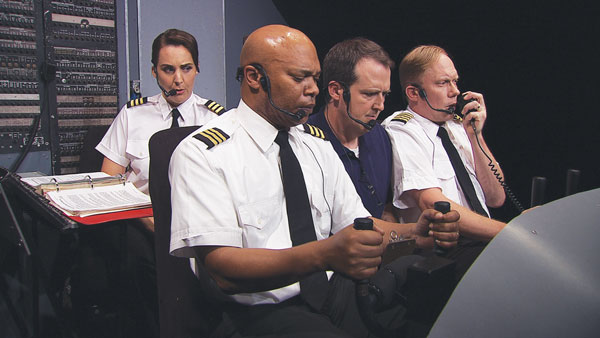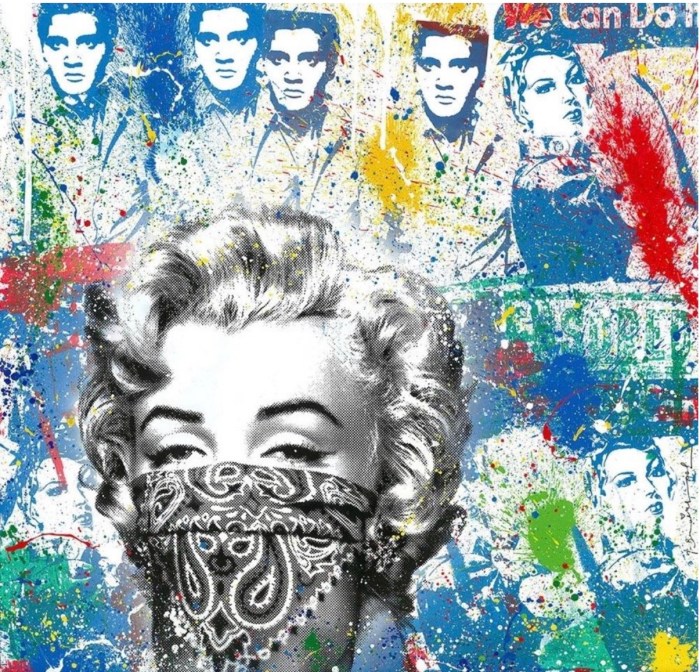
R to L: Nora Woolley, Irving Gregory, Sam Zuckerman and Patrick Daniels.
BY TRAV S.D. (travsd.wordpress.com) | “Charlie Victor Romeo” may be the most cost-effective disaster movie ever made. Longtime Downtown theatre fans are well familiar with this pocket-sized but ambitious show, which started at Collective: Unconscious’s tiny Ludlow Street storefront theatre in 1999, with later incarnations at P.S. 122, the Edinburgh Fringe Festival and 3LD Art & Technology Center. Performances at the latter venue were shot (in 3-D!) in 2012 and form the basis of the film.
Shows this small don’t usually stay alive for fourteen years (and counting), but then, most of them don’t offer a journey as compelling or as harrowing as “Charlie Victor Romeo.” The title is aviation jargon for “cockpit voice recorder,” a.k.a. the black box that investigators always scrutinize in the wake of an air disaster. The script of the theatre-piece (and now the film) is drawn from transcriptions of the moments immediately prior to six airplane crashes that occurred between 1985 and 1996.
One of the disconcerting things about the experience is the number and variety of things that can go wrong — sometimes fatally — when you’re flying hundreds of miles an hour ten thousand feet off the ground.
Thousands of factors are involved in getting you safely to your destination, and stuff can go catastrophically wrong with any one of those factors: glitches in manufacture, maintenance, pilot error, bad weather. The six stories in “Charlie Victor Romeo” hit all the major areas, helpfully clarifying the chaotic events with diagrams, charts, data and the verdicts of FAA investigators.
As theatre, there is precedent for Collective: Unconsciousness’s “documentary” approach in the work of Anne Devere Smith and others. Obviously not all real-life dialogue is grist for great drama, but I think I am not alone in finding “Charlie Victor Romero” among the most riveting ninety minutes or so I have ever spent in a theatre. Expertly acted by a cast of seven, it took you on an emotional hellride ranging from grim concern to fear to despair to moments of light, thoughtless chitchat (which in some ways are the most terrifying moments of all — think about it).
The main virtue of the film is that now these terrific performances are preserved and can travel beyond the confines of tiny New York and Fringe theatres. When I first heard it had been made into a movie, I had visions of a full adaptation, with real planes and special effects, or perhaps green screens providing a sky and clouds outside the cockpit window. But instead, this is a full-on documentary record of a theatre performance. (I was startled to learn in the credits that it was taped before a live audience, because, tellingly, you can hear a pin drop.) Normally, “filmed theatre” is sort of a drag, the kind of thing you see on PBS. Occasionally it can be effective, depending on the strength of the performances, but graphically it can be unbearably static.
Because of the singular nature of this piece, however, that potential pitfall doesn’t apply here. While the set is literally comparable to the cockpit set Ed Wood used in “Plan 9 from Outer Space,” we are so drawn into these moments and performances and so into the character’s heads that it comes close to being like listening to radio theatre (and the sound design is one of the many strong points of both the theatre piece and the film). But the expressions on the actors’ faces are so crucial, too. The performances, simple and unadorned by any nonsense, are all uniformly terrific.
There is lesson here that I hope Hollywood learns. With very little set and no special effects, we have a movie that is all thrills, the equivalent of the climaxes of six disaster movies — and in many ways, more effective. I don’t need any CGI; the sweat rolling off a pilot’s worried forehead affects me just fine.
The ultimate benefit of the film may come from a home video release, if it gets one. When I saw the live stage production about a decade ago, when it was over I definitely wanted to hang on to the experience, ask questions, rewind it and watch certain crucial, elusive moments again. It’s easy to get obsessive about “Charlie Victor Romeo.”
— Trav S.D. has been producing the American Vaudeville Theatre since 1995, and periodically trots it out in new incarnations. Stay in the loop at travsd.wordpress.com, and also catch up with him on Twitter, Facebook, YouTube, et al. His books include “No Applause, Just Throw Money: The Book That Made Vaudeville Famous” and “Chain of Fools: Silent Comedy and its Legacies from Nickelodeons to YouTube.”
FILM
CHARLIE VICTOR ROMEO
Written by Robert Berger, Patrick Daniels and Irving Gregory
Co-Directed by Robert Berger, Patrick Daniels and Karlyn Michelson
80 minutes
In 3-D
Through Feb. 11
Screenings at 1, 2:45, 4:30, 6:15, 8 & 10pm
At Film Forum
209 W. Houston St., W. of Sixth Ave.
Visit filmforum.org

















